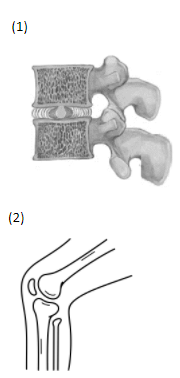
A lubricant, mucin in saliva is made up of?


Answer
495.3k+ views
Hint: The diagram (1) represents the facet joints which are found in the vertebra. The facet joints are in between articular facets. This type of vertebra is designed for specialised functions.
Complete answer:
We already know that our body is made up of joints which help in holding the skeleton together. There are three types of joints which are found in our body.
Fibrous joint- In this the bones are joined by thick connective tissue that are rich in collagen. Ex- Joints present in cranium.
Synovial joint- In this joint, a fluid filled cavity is present in between the bones of the joint. Ex- Knee joint.
Cartilaginous joint- In this type of joints, the bones are joined by cartilage.
The vertebral joints shown in the fig. (1) in our body are cartilaginous joints whose articular surfaces are covered with the hyaline cartilage. These are connected by the intervertebral discs. In the vertebral column each vertebra has four facet joints in which one pair joins to the vertebra above, one with the vertebra below, The superior and inferior facets connect each vertebra. These joints are called intervertebral joints.
Function :
These joints are cartilaginous joints which are designed for bearing weight and provide strength to the vertebra. The facets allow help in gliding motion between the vertebrae.
The fig. (2) represents the synovial joint in which a fluid filled cavity is present in between two bones. The cavity provides extra cushioning to the ends of the bones. The bones are actually held together by ligaments. It is found in the knee.
Note: Joints present in the body help in binding the skeleton together into the structure which allows the muscles to move the bones and thus help in running, grasping etc. Knee joint is the largest and the most complex joint present in our body. The joints present in the knee are freely movable joints.
Complete answer:
We already know that our body is made up of joints which help in holding the skeleton together. There are three types of joints which are found in our body.
Fibrous joint- In this the bones are joined by thick connective tissue that are rich in collagen. Ex- Joints present in cranium.
Synovial joint- In this joint, a fluid filled cavity is present in between the bones of the joint. Ex- Knee joint.
Cartilaginous joint- In this type of joints, the bones are joined by cartilage.
The vertebral joints shown in the fig. (1) in our body are cartilaginous joints whose articular surfaces are covered with the hyaline cartilage. These are connected by the intervertebral discs. In the vertebral column each vertebra has four facet joints in which one pair joins to the vertebra above, one with the vertebra below, The superior and inferior facets connect each vertebra. These joints are called intervertebral joints.
Function :
These joints are cartilaginous joints which are designed for bearing weight and provide strength to the vertebra. The facets allow help in gliding motion between the vertebrae.
The fig. (2) represents the synovial joint in which a fluid filled cavity is present in between two bones. The cavity provides extra cushioning to the ends of the bones. The bones are actually held together by ligaments. It is found in the knee.
Note: Joints present in the body help in binding the skeleton together into the structure which allows the muscles to move the bones and thus help in running, grasping etc. Knee joint is the largest and the most complex joint present in our body. The joints present in the knee are freely movable joints.
Recently Updated Pages
Why is there a time difference of about 5 hours between class 10 social science CBSE

In cricket, what is a "pink ball" primarily used for?

In cricket, what is the "new ball" phase?

In cricket, what is a "death over"?

What is the "Powerplay" in T20 cricket?

In cricket, what is a "super over"?

Trending doubts
What is meant by exothermic and endothermic reactions class 11 chemistry CBSE

Which animal has three hearts class 11 biology CBSE

10 examples of friction in our daily life

One Metric ton is equal to kg A 10000 B 1000 C 100 class 11 physics CBSE

1 Quintal is equal to a 110 kg b 10 kg c 100kg d 1000 class 11 physics CBSE

Difference Between Prokaryotic Cells and Eukaryotic Cells




